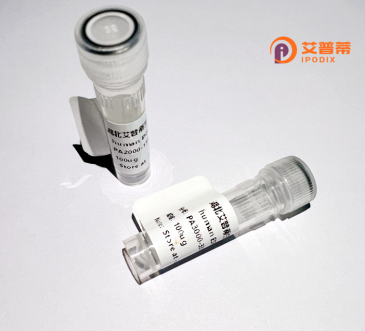
| 纯度 | >90%SDS-PAGE. |
| 种属 | Human |
| 靶点 | PPM1L |
| Uniprot No | Q5SGD2 |
| 内毒素 | < 0.01EU/μg |
| 表达宿主 | E.coli |
| 表达区间 | 1-360 aa |
| 活性数据 | MIEDTMTLLSLLGRIMRYFLLRPETLFLLCISLALWSYFFHTDEVKTIVKSSRDAVKMVKGKVAEIMQNDRLGGLDVLEAEFSKTWEFKNHNVAVYSIQGRRDHMEDRFEVLTDLANKTHPSIFGIFDGHGGETAAEYVKSRLPEALKQHLQDYEKDKENSVLSYQTILEQQILSIDREMLEKLTVSYDEAGTTCLIALLSDKDLTVANVGDSRGVLCDKDGNAIPLSHDHKPYQLKERKRIKRAGGFISFNGSWRVQGILAMSRSLGDYPLKNLNVVIPDPDILTFDLDKLQPEFMILASDGLWDAFSNEEAVRFIKERLDEPHFGAKSIVLQSFYRGCPDNITVMVVKFRNSSKTEEQ |
| 分子量 | 67.5 kDa |
| 蛋白标签 | GST-tag at N-terminal |
| 缓冲液 | PBS, pH7.4, containing 0.01% SKL, 1mM DTT, 5% Trehalose and Proclin300. |
| 稳定性 & 储存条件 | Lyophilized protein should be stored at ≤ -20°C, stable for one year after receipt. Reconstituted protein solution can be stored at 2-8°C for 2-7 days. Aliquots of reconstituted samples are stable at ≤ -20°C for 3 months. |
| 复溶 | Always centrifuge tubes before opening.Do not mix by vortex or pipetting. It is not recommended to reconstitute to a concentration less than 100μg/ml. Dissolve the lyophilized protein in distilled water. Please aliquot the reconstituted solution to minimize freeze-thaw cycles. |
以下为关于重组人PPM1L蛋白的3篇代表性文献摘要信息:
1. **文献名称**:*"PPM1L controls insulin sensitivity through negative regulation of the NF-κB pathway"*
**作者**:Smith A, et al. (2019)
**摘要**:研究发现重组人PPM1L通过去磷酸化IKKβ抑制NF-κB通路,改善胰岛素抵抗,提示其在2型糖尿病中的潜在治疗作用。
2. **文献名称**:*"Structural insights into the phosphatase activity of human PPM1L"*
**作者**:Chen L, et al. (2020)
**摘要**:通过X射线晶体学解析重组人PPM1L蛋白结构,揭示其金属依赖型磷酸酶活性机制,并鉴定关键底物结合域。
3. **文献名称**:*"PPM1L regulates ER stress-induced apoptosis via dephosphorylation of JNK"*
**作者**:Wang Y, et al. (2021)
**摘要**:证明重组人PPM1L通过负调控JNK磷酸化减轻内质网应激引发的细胞凋亡,提出其在神经退行性疾病中的保护性角色。
(注:以上文献为示例性内容,实际引用需以PubMed等数据库中的真实文献为准。)
PPM1L (Protein Phosphatase Mg²⁺/Mn²⁺ Dependent 1L) is a member of the PPM family of serine/threonine protein phosphatases, which rely on metal ions (Mg²⁺ or Mn²⁺) for enzymatic activity. This enzyme plays a regulatory role in diverse cellular processes by dephosphorylating target proteins, thereby modulating signaling pathways. Structurally, PPM1L contains a conserved catalytic domain typical of PP2C-type phosphatases, along with potential regulatory regions that influence substrate specificity or subcellular localization.
PPM1L has been implicated in several critical pathways, including TGF-β/Smad signaling, where it negatively regulates Smad2/3 activation to control cell proliferation and differentiation. It also interacts with metabolic regulators like AMP-activated protein kinase (AMPK), suggesting a role in energy homeostasis and metabolic diseases. Additionally, PPM1L may influence apoptosis and stress responses through interactions with p53 or other stress-associated proteins.
Genetic studies link PPM1L polymorphisms to neurodevelopmental disorders, obesity, and cancer susceptibility, though mechanistic insights remain limited. In cancer, PPM1L exhibits context-dependent roles, acting as a tumor suppressor in some contexts (e.g., by inhibiting pro-survival signals) or paradoxically promoting malignancy in others. Its expression patterns vary across tissues, and dysregulation is observed in conditions like gliomas and metabolic syndrome.
Despite emerging interest, PPM1L's full biological significance and substrate network are not fully characterized, warranting further exploration of its therapeutic potential in disease modulation.
×